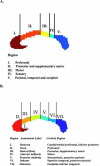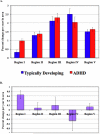Developmental trajectories of the corpus callosum in attention-deficit/hyperactivity disorder
- PMID: 21247556
- PMCID: PMC3078980
- DOI: 10.1016/j.biopsych.2010.11.024
Developmental trajectories of the corpus callosum in attention-deficit/hyperactivity disorder
Abstract
Background: It was recently found that the development of typical patterns of prefrontal, but not posterior, cortical asymmetry is disrupted in right-handed youth with attention-deficit/hyperactivity disorder (ADHD). Using longitudinal data, we tested the hypothesis that there would be a congruent disruption in the growth of the anterior corpus callosum, which contains white matter tracts connecting prefrontal cortical regions.
Methods: Areas of five subregions of the corpus callosum were quantified using a semiautomated method from 828 neuroanatomic magnetic resonance scans acquired from 236 children and adolescents with ADHD (429 scans) and 230 typically developing youth (399 scans), most of whom had repeated neuroimaging. Growth rates of each diagnostic group were defined using mixed-model linear regression.
Results: Right-handed participants with ADHD showed a significantly higher rate of growth in the anterior-most region of the corpus callosum (estimated annual increase in area of .97%, SEM .12%) than their typically developing peers (annual increase in area of .32% SEM .13%; t = 3.64, p = .0003). No significant diagnostic differences in growth rates were found in any other regions in right-handed participants, and no significant diagnostic differences were found in non-right-handed participants.
Conclusions: As hypothesized, we found anomalous growth trajectories in the anterior corpus callosum in ADHD. This disrupted anterior callosal growth may reflect, or even drive, the previously reported disruption in the development of prefrontal cortex asymmetry. The finding documents the dynamic, age-dependent nature of callosal and congruent prefrontal cortical abnormalities characterizing ADHD.
Copyright © 2011 Society of Biological Psychiatry. Published by Elsevier Inc. All rights reserved.
Figures




Similar articles
-
Development of cortical asymmetry in typically developing children and its disruption in attention-deficit/hyperactivity disorder.Arch Gen Psychiatry. 2009 Aug;66(8):888-96. doi: 10.1001/archgenpsychiatry.2009.103. Arch Gen Psychiatry. 2009. PMID: 19652128 Free PMC article.
-
Decreased callosal thickness in attention-deficit/hyperactivity disorder.Biol Psychiatry. 2009 Jan 1;65(1):84-8. doi: 10.1016/j.biopsych.2008.08.027. Epub 2008 Oct 8. Biol Psychiatry. 2009. PMID: 18842255 Free PMC article.
-
Attention-deficit hyperactivity disorder: magnetic resonance imaging morphometric analysis of the corpus callosum.J Am Acad Child Adolesc Psychiatry. 1994 Jul-Aug;33(6):875-81. doi: 10.1097/00004583-199407000-00014. J Am Acad Child Adolesc Psychiatry. 1994. PMID: 8083145
-
[Structural and functional neuroanatomy of attention-deficit hyperactivity disorder (ADHD)].Encephale. 2009 Apr;35(2):107-14. doi: 10.1016/j.encep.2008.01.005. Epub 2008 Jul 7. Encephale. 2009. PMID: 19393378 Review. French.
-
Structural brain imaging of attention-deficit/hyperactivity disorder.Biol Psychiatry. 2005 Jun 1;57(11):1263-72. doi: 10.1016/j.biopsych.2004.11.019. Epub 2005 Jan 22. Biol Psychiatry. 2005. PMID: 15949998 Review.
Cited by
-
Emotion-Cognition Interactions in Attention-Deficit/Hyperactivity Disorder: Increased Early Attention Capture and Weakened Attentional Control in Emotional Contexts.Biol Psychiatry Cogn Neurosci Neuroimaging. 2020 May;5(5):520-529. doi: 10.1016/j.bpsc.2019.12.021. Epub 2020 Jan 15. Biol Psychiatry Cogn Neurosci Neuroimaging. 2020. PMID: 32198002 Free PMC article.
-
Automated measurement of the human corpus callosum using MRI.Front Neuroinform. 2012 Sep 12;6:25. doi: 10.3389/fninf.2012.00025. eCollection 2012. Front Neuroinform. 2012. PMID: 22988433 Free PMC article.
-
Can you hear me now? Musical training shapes functional brain networks for selective auditory attention and hearing speech in noise.Front Psychol. 2011 Jun 13;2:113. doi: 10.3389/fpsyg.2011.00113. eCollection 2011. Front Psychol. 2011. PMID: 21716636 Free PMC article.
-
Adult ADHD: Risk Factor for Dementia or Phenotypic Mimic?Front Aging Neurosci. 2017 Aug 3;9:260. doi: 10.3389/fnagi.2017.00260. eCollection 2017. Front Aging Neurosci. 2017. PMID: 28824421 Free PMC article.
-
BAIAP2 exhibits association to childhood ADHD especially predominantly inattentive subtype in Chinese Han subjects.Behav Brain Funct. 2013 Dec 30;9:48. doi: 10.1186/1744-9081-9-48. Behav Brain Funct. 2013. PMID: 24377651 Free PMC article.
References
-
- Shaw P, Lerch J, Greenstein D, Sharp W, Clasen L, Evans A, et al. Longitudinal mapping of cortical thickness and clinical outcome in children and adolescents with attention deficit/hyperactivity disorder. Archives of General Psychiatry. 2006;63:540–549. - PubMed
Publication types
MeSH terms
Grants and funding
LinkOut - more resources
Full Text Sources
Medical
Research Materials

